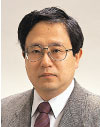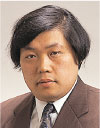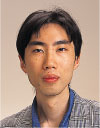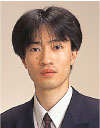|
|
 |
|
|
Center for Mathematical Sciences |

Hiroyuki Sagawa
Professor |

Noriaki Kamiya
Professor |

Katsutaro Shimizu
Associate Professor |

Ken-ichi Funahashi
Associate Professor |

Toshiro Watanabe
Assistant Professor |

Kazuto Asai
Assistant Professor |

Michio Honma
Assistant Professor |

Shigeru Watanabe
Assistant Professor |

Hiroshi Kihara
Assistant Professor |
|
The scope of activities of the Center for Mathematical Sciences spans all aspects of research and education in the fields of mathematical sciences. Our current researches in the field of mathematics are devoted to various subjects and problems Centers arising in both pure and applied mathematics: non-associative algebras, neural networks, unimodality problems, algebraic combinatorics, spherical functions, and homotopy theory.
In the fields of physics, theoretical research is performed in many-body theories, nuclear physics, quantum gravity and quantum mechanics of constrain system. There has been also a project to develop educational textbooks and software for mechanics, electromagnetism and quantum mechanics. The research areas assigned to each co-researcher are as follows:
| Prof. H. Sagawa | studies the physics of the many-body system of including nuclei and microclusters and quantum information theory. |
| Prof. N. Kamiya | studies the theory of non-associative algebras and a structure theory of algebras from triple systems |
| Prof. K. Funahashi | researches the theory of the neural networks and function theory of several complex variables from a geometrical viewpoint |
| Prof. K. Shimizu | advances the traditional quantum theory and creates the geometrical theory of quantum gravity |
| Prof. T. Watanabe | generalizes the unimodality problems of 1-dimensional infinitely divisible distributions to multi-dimensional cases in the use of analytical methods |
| Prof. K. Asai | researches combinatorial identities for generalized Young tableaux, and also, several generating functions arising from algebraic combinatorics |
| Prof. S. Watanabe | studies geometrical interpretations of generating functions for spherical functions on homogeneous spaces |
| Prof. M. Honma | researches the microscopic structures and dynamics of the nuclei by the algebraic methods and geometrical models performing the quantitative analysis by the large-scale numeric calculations |
| Prof. H. Kihara | studies homotopy theory and its applications to various areas of mathematics |
|
| [kamiya-01:2002] | N. Kamiya and S.Okubo. Constraction of Lie super algebras D(2,1 .), G(3), and F(4) from some triple systems Proc EdinburMath. 2003 ,to appear. 2002. |
| [kamiya-02:2002] | N. Kamiya and Okubo Elduque. simple (-1,-1)balanced Freudenthal-Kantor triple systems Glasgow Math.J. 2003 ,to apear. 2002. |
| [m-honma-01:2002] | Takahiro Mizusaki Michio Honma, B. Alex Brown and Takaharu Otsuka. Full pf-shell calculations with a new effective interaction. Nucl. Phys. A, 704:134-143, 2002.
A new effective interaction is presented for pf-shell-model calculations. Starting from a realistic G-matrix interaction based on the Bonn-Cpotential, two-body matrix elements and single particle energies are determined by fitting to 635 binding and excitation energy data in the mass range 47 to 69. The derived interaction is found to be quite successful in describing the systematics of binding and excitation energies, effective single particle energies, isospin structure of the lowest states, including those of N =Z odd-odd nuclei and N or Z=28 nuclei. |
| [m-honma-02:2002] | B. Alex Brown Michio Honma, Takaharu Otsuka and Takahiro Mizusaki. Effective interaction for pf-shell nuclei. Phys. Rev. C, 65:061301(R)/1-5, 2002.
An effective interaction is derived for use in the full pf basis. Starting from a realistic G-matrix interaction, 195 two-body matrix elements and 4 single-particle energies are determined by fitting to 699 energy data in the mass range 47 to 66. The derived interaction successfully describes various structures of pf-shell nuclei. As examples, systematics of the energies of the first 2+ states in the Ca, Ti, Cr, Fe, and Ni isotope chains and energy levels of Ni(56, 57, 58) are presented. The appearance of a new magic number 34 is seen. |
| [m-honma-03:2002] | Serdar Kuyucak and Michio Honma. Mean field study of the quadrupole-octupole degree of freedom in the spdf boson model. Phys. Rev. C, 65:064323/1-14, 2002.
We present a mean field study of the quadrupole-octupole degree of freedom in collective nuclei within the framework of the spdf-boson model. For realistic choices of the Hamiltonian parameters, the ground state of the system is shown to remain axially symmetric, which considerably simplifies the mean field treatment. The critical point for the onset of octupole deformation in quadrupole deformed systems is identified in the parameter space and importance of the parity projection in this process is emphasized. A systematic survey of excitation energies and electric transitions for one-phonon states is given, which will provide useful guidance for detailed studies of negative parity states within the spdf-boson model. |
| [m-honma-04:2002] | P. F. Mantica B. A. Brown R. Broda P. Bhattacharyya M. P. Carpenter M. Cinausero P. J. Daly A. D. Davies T. Glasmacher Z. W. Grabowski D. E. Groh M. Honma F. G. Kondev W. Krolas T. Lauritsen S. N. Liddick S. Lunardi N. Marginean T. Mizusaki D. J. Morrissey A. C.MortonW.F. Mueller T. Otsuka T. Pawlat D. Seweryniak H. Schatz A. Stolz S. L. Tabor C. A. Ur G. Viesti I. Wiedenh R. V. F. Janssens, B. Fornal. |
| [m-honma-05:2002] | B. A. Brown A. D. Davies T. Glasmacher D. E. Groh S. N.
Liddick D. J. Morrissey W. F. Mueller H. Schatz A. Stolz S. L. Tabor
M. Honma M. Horoi P. F. Mantica, A. C. Morton and T. Otsuka.  decay studies of the neutron-rich V isotopes. Phys. Rev. C, 67:014311/1-12, 2003. decay studies of the neutron-rich V isotopes. Phys. Rev. C, 67:014311/1-12, 2003. |
| [sagawa-01:2002] | H. Sagawa. Neutron Skin and Isospin Structure of Giant Resonances. Phys. Rev., C65:064314 pp.1-7, 2002.
Neutron number dependence of neutron skin thickness in several isotopes is discussed by using Skyrme Hartree-Fock (HF) calculations. It is shown that the size of neutron skin is proportional to one-third power of the neutron number in all the isotopes studied although the central density varies substantially in each isotope. Isospin structure of giant quadrupole resonances (GQR) is also studied in self-consistent HF and random phase approximation (RPA). The isovector GQR is found to be a good isospin mode even in very neutron-rich nuclei, while the isoscalar GQR shows a large deviation from the pure isospin mode in neutron-rich C- and O-isotopes due to a strong neutron skin effect. |
| [sagawa-02:2002] | H. Sagawa. Decoupling and coherence in E1 and E2moments in nuclei near drip lines. Europian Physics Journal, A13:87-92, 2002.
We study decoupling and coherence in E1 and E2 moments in nuclei near drip lines Be and O. |
| [sagawa-03:2002] | I. Hamamoto and H. Sagawa. NewAspects of Nuclear Structure near Drip Lines. Nuclear Physics News International, 12:21-29, 2002.
Recent development of the facilities of radioactive nuclear ion beams (RNB) opens a new era of exploring the structure and reaction mechanism of nuclei far away from the  stability line. The proton drip line is experimentally approached up till Pb isotopes, while the neutron drip line is known at this moment for Z stability line. The proton drip line is experimentally approached up till Pb isotopes, while the neutron drip line is known at this moment for Z 8. The latter for Z28 may be reached in the present decade using currently planned RNB facilities. The fundamental properties unique in drip line nuclei compared with 8. The latter for Z28 may be reached in the present decade using currently planned RNB facilities. The fundamental properties unique in drip line nuclei compared with  stable nuclei may be summarized as : (a) presence of nucleons with very small binding energies and the largely exten ded wave-functions ; (b) large difference between the Fermi levels of protons and neutrons ; (c) exotic ratio of the proton to neutron numbers for a given mass number. stable nuclei may be summarized as : (a) presence of nucleons with very small binding energies and the largely exten ded wave-functions ; (b) large difference between the Fermi levels of protons and neutrons ; (c) exotic ratio of the proton to neutron numbers for a given mass number. |
| [sagawa-04:2002] | I. Hamamoto and H. Sagawa. Isoscalar dipole strength in  : the spurious mode and the strength in the continuum. Phys. Rev., C66:044315 pp. 1-7, 2002. : the spurious mode and the strength in the continuum. Phys. Rev., C66:044315 pp. 1-7, 2002.
Isoscalardipole (compression)mode is studied first using schematic harmonicoscillator model and, then, the self-consistent Hartree-Fock(HF) and random phase approximation(RPA) solved in coordinate space. Taking  and the SkM* interaction as a numerical example, the spurious component and the strength in the continuum are carefully examined using the su m rules. It is pointed out that in the continuum calculation one has to use an extremely fine radial mesh in HF and RPA in order to separate, with good accuracy, the spurious component from intrinsic excitations. and the SkM* interaction as a numerical example, the spurious component and the strength in the continuum are carefully examined using the su m rules. It is pointed out that in the continuum calculation one has to use an extremely fine radial mesh in HF and RPA in order to separate, with good accuracy, the spurious component from intrinsic excitations. |
| [t-watanb-01:2002] | T. Watanabe. Limit Theorems for shift selfsimilar additive random sequences. Osaka,J. Math., 39(3):561-603, 2002.
We introduce shift selfsimilar additive random sequences. We characterize those sequences and then give a nexessary and sufficient condition for them to be transient. We also discuss the rate of growth of them in ditail. |
| [sagawa-05:2002] | H. Sagawa and N. Yoshida. Quantum Information Theory. Springer-Verlag Tokyo, 2002. |
| [sagawa-06:2002] | H. Sagawa. Ministry of Education Scienti??c Research Fund C2, 1999-2003. |
| [sagawa-07:2002] | H. Sagawa, Nov. 2002. Chairman of the organizing committee, Int. Symposium of Frontier of Collective |
| [sagawa-08:2002] | Makito Watanabe. Graduation Thesis:NMR and Quantum Algorithms, University of Aizu, 2002.
Thesis Advisor: H. Sagawa |
| [sagawa-09:2002] | Natsuki Hori. Graduation Thesis:Energy of Adiabatic Quantum Search Algorithms, University of Aizu, 2002.
Thesis Advisor: H. Sagawa |
| [sagawa-10:2002] | Masaki Fujimoto. Graduation Thesis:Security of BB84 and B92 Protocol, University of Aizu, 2002.
Thesis Advisor: H. Sagawa |
| [sagawa-11:2002] | Daisuke Noda. Graduation Thesis:Quantum Bit and Quantum Logic Gate by Quantum Dot, University of Aizu, 2002.
Thesis Advisor: H. Sagawa |
| [sagawa-12:2002] | Yuji Konno. Graduation Thesis:Shor's Factorization Algorithm by Quantum Parallelism, University of Aizu, 2002.
Thesis Advisor: H. Sagawa |
| [sigeru-w-01:2002] | Kumiko Kobayashi. Graduation Thesis: Linear Programming, University of Aizu, 2002.
Thesis Advisor: Watanabe, S |
| [sigeru-w-02:2002] | Kouji Satou. Graduation Thesis: Statistical Methods for Environmental Risk Test, University of Aizu, 2002.
Thesis Advisor: Watanabe, S |
| [sigeru-w-03:2002] | Michiyo Tokuda. Graduation Thesis: An Analysis of Social Phenomena using Di??erential Equations, University of Aizu, 2002.
Thesis Advisor: Watanabe, S |
| [k-asai-01:2002] | Kazuto Asai. Algebraic Systems and Combinatorics - Finite Fields -, 2002.
A textbook for the graduate class: Algebraic Systems and Combinatorics |
| [kihara-01:2002] | Hiroshi Kihara. Homotopical Algebra of Double Complexes, October 2002.
Symposium on Homotopy Theory |
| [kihara-02:2002] | Hiroshi Kihara. Simplicial Homotopy Theory(Introduction), September 2002.
Algebraic Models of Spaces and Their Perspectives(at Okayama University) |
| [kihara-03:2002] | Hiroshi Kihara. Homotopical Algebra(Introduction), September 2002.
Algebraic Models of Spaces and Their Perspectives(at Okayama University) |
|